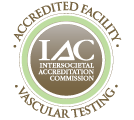Abdominal Aortic Aneurysm (AAA)
The aorta is a major blood vessel that runs from your heart through the central part of your chest and abdomen. It is the main supply route of blood to your body. An abdominal aortic aneurysm (AAA) occurs when a part of the aorta widens or becomes significantly enlarged (bulging) in the abdominal area. Once diagnosed, doctors will monitor it very closely. A ruptured aneurysm can cause bleeding that may be life threatening. The larger the aneurysm, the higher the risk of it rupturing. Fortunately, enlarged aneurysms can be repaired, the sooner the better.
Causes of AAA
While the exact cause is not known, AAA is believed to occur due to weakening of the aortic walls. Here are some factors that can increase the risk of having an abdominal aortic aneurysm:
- High blood pressure
- Smoking
- High cholesterol
- Other heart diseases or blood vessel related problems
- Being overweight
- Abdominal trauma
- Family history of aneurysms
AAAs are typically seen in individuals who are over 50, more frequently in men rather than women, and individuals that have genetic or other risk factors. A majority of these aneurysms occur below the kidneys. In 2013, aortic aneurysms were said to have resulted in 152,000 deaths.
Signs and Symptoms of AAA
Abdominal aortic aneurysms often present no symptoms and can develop slowly for years without the affected individual being aware of the progressive condition. Symptoms may only manifest if the aneurysm grows rapidly or causes a tear or rupture.
Some signs of an AAA include:
- Severe, sudden or persistent pain in the abdomen or back that may spread to legs, buttocks or groin
- Dizziness, nausea and vomiting
- Rapid heart rate
- Sweating
- Shock or losing consciousness
Slow growing or small aneurysms that are less than 6cms in size have a lower risk of rupture when compared to the larger, fast growing ones that are more than 7cms.
AAA Diagnosis
If your doctor suspects that you have an abdominal aortic aneurism, he/she will examine your abdomen and check the pulse in your legs. You will then be referred for further testing which may involve an abdominal CT scan, ultrasound, MRI and/or computerized tomography (CT). This will confirm whether you have an AAA as well as the location and size of the aneurism. Patients that also experience chest pains may be told to have a chest x-ray and/or electrocardiogram (also known as an ECG or EKG) as well.
According to the U.S. Preventive Services Task Force, men in the age group of 65–75 years who have a history of smoking should get an ultrasound screening for abdominal aortic aneurysms, even if they have no symptoms.
How is Abdominal Aortic Aneurysm Treated?
If you are bleeding because of AAA rupture, you will be scheduled for immediate surgery. Surgery is of two types—open repair where the abnormal part of the aorta is replaced with a man-made graft, or endovascular stent graphing which is a newer and less invasive form of surgery. Surgical repair may also be performed if your aneurism is large and the risk of it rupturing is high. Slow-growing or small aneurisms are usually monitored with the help of regular scans.
Treating high blood pressure and cholesterol, and maintaining optimal weight can help in the prevention of AAA among high-risk patients.
Our team at The Vascular Experts can help detect if you or a loved one is suffering from an abdominal aortic aneurysm. Using advanced technologies and our team’s extensive experience with treating simple and chronic AAA, we can help effectively manage your condition. We are committed to providing a high level of preventative care and treatments to our patients.



